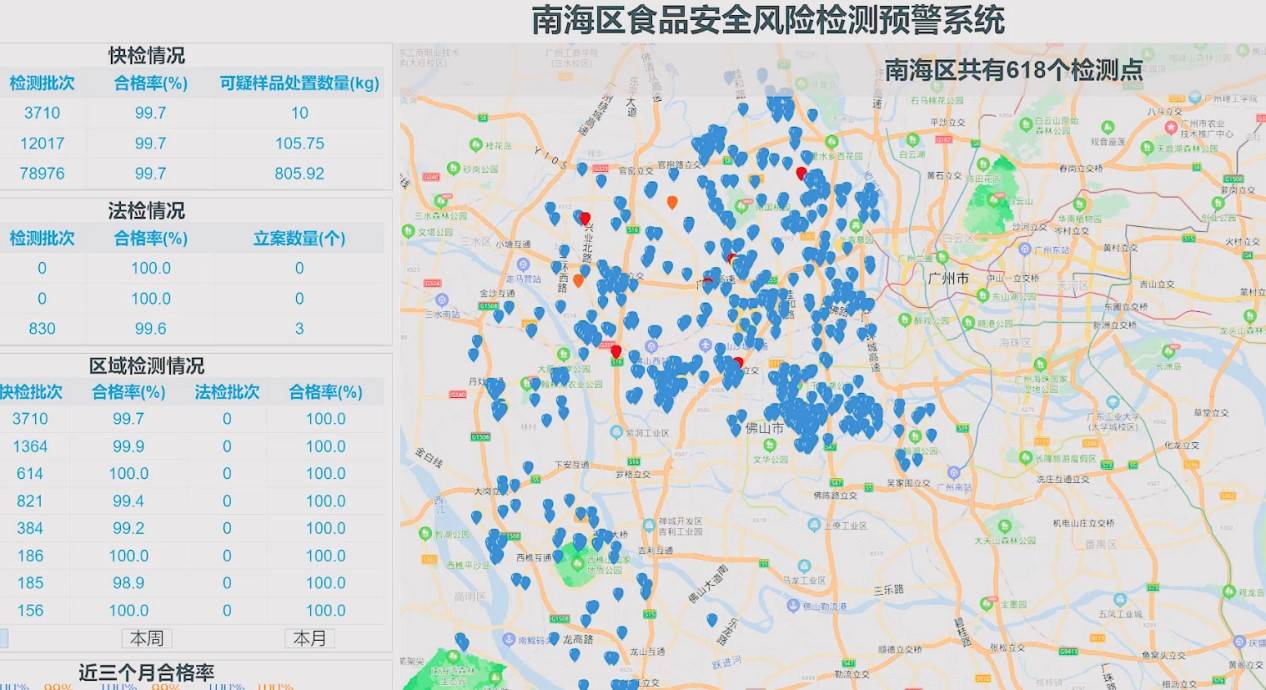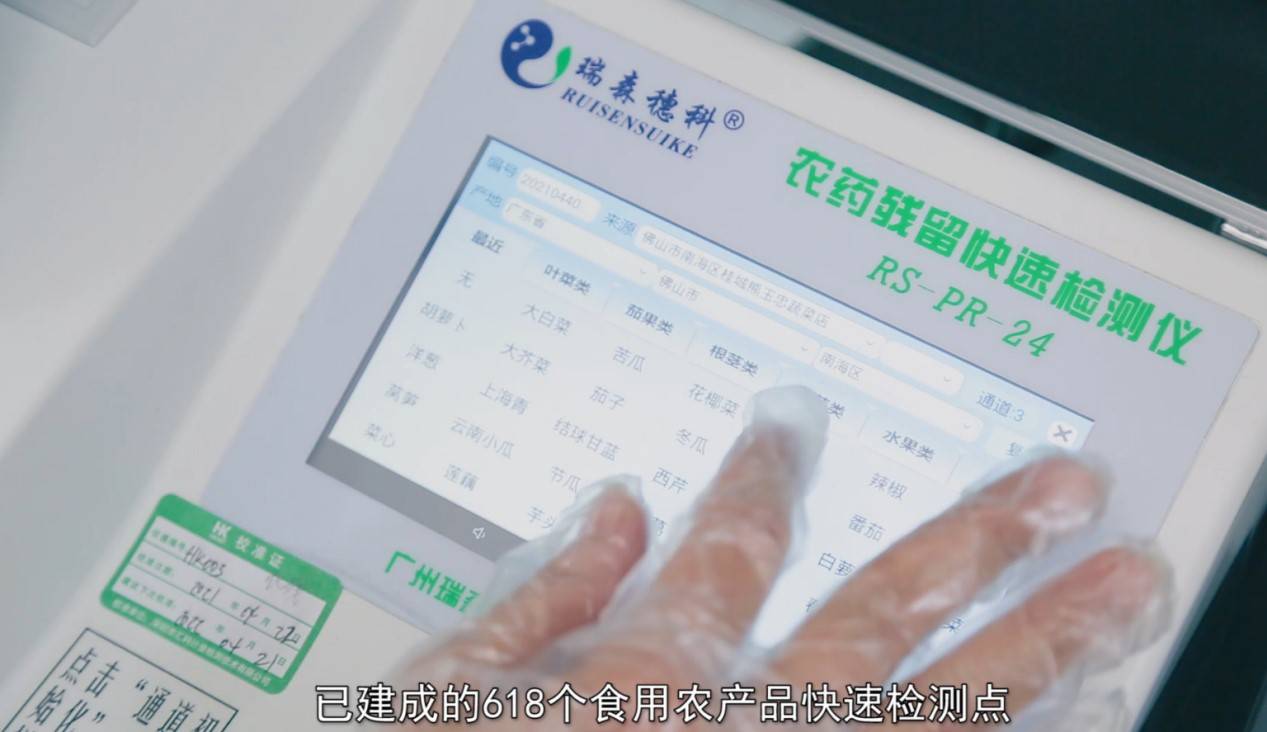Foshan News Network reporter Lu Huichang reported: Food safety affects thousands of households. On May 26, the Nanhai District Farmer’s Market Upgrade Mobilization and Food Safety Risk Detection and Early Warning System Launch Ceremony was held, emphasizing that risk detection and early warning should be taken as the starting point and the use of information technology to detect and eliminate food safety risks.
Digitalization empowers food safety risk management and control. Since 2020, Nanhai District has been continuously optimizing and accelerating the layout. The construction of the food safety risk detection and early warning system has progressed as scheduled, and the detection data has been uploaded and monitored in real time.
Since the launch of the food safety risk detection and early warning system on September 23, 2020, as of March 28, 2021, a total of 450,694 batches of rapid inspection data have been generated and collected, of which 4834 batches of positive suspicious samples were detected, with a suspicious rate of 1.1 %. 19.7 tons of edible agricultural products involving positive batches have all been initiated follow-up disposal mechanisms for harmless treatment and traceability, effectively ensuring the safety of the people’s tongue.

Big data empowers to realize food safety risk management and control in advance
“Food safety” is a core topic of concern to the whole society, and governments at all levels are under “pressure”. The quality and safety of agricultural products and food still have problems such as “difficult supervision, difficult law enforcement, and disorderly competition in the market”.
Focus on Nanhai District. At present, Nanhai District invests millions of financial funds for food sampling inspection every year. A large amount of result data is obtained in daily work. If these data can be used reasonably, centralized evaluation and analysis and unified forecasting and judgment can be carried out. Realize the early warning of food safety risks, and then realize the risk management and control in advance.
Therefore, in order to enhance the effectiveness of food safety supervision, maximize supervision efficiency, optimize supervision costs, and improve the level of food safety in Nanhai District, the Nanhai District Market Supervision Administration has innovated work ideas, proposed big data development concepts, and introduced food safety risk detection in Nanhai District. The early warning system does practical things for the masses.
It is understood that the system conducts centralized evaluation, analysis and unified prediction and judgment on a large amount of random inspection data generated in daily edible agricultural products quick inspection and food supervision and random inspection, establishes a risk assessment management system, and realizes risk early warning and forecasting and pre-control functions.

Currently, the system collects about 4,000 test data every day. The data comes from the 618 edible agricultural products rapid testing points that have been established in Nanhai District, covering farmer’s markets, primary and secondary schools, government agencies, catering centers, hospitals, supermarkets, etc. The detection points are equipped with new pesticide residue detectors, and all pesticide residue fast detectors realize the direct upload of detection results and process data.
The intelligent system uses big data analysis technology to issue early warnings to companies that fail to conduct pesticide residue detection on time and in accordance with the amount, and issue risk warnings to high-risk vegetable varieties and vegetable supply companies.
It is worth mentioning that the system’s early warning and hierarchical disposal mechanism automatically pushes risk warning information to the corresponding supervisors through mobile phone WeChat, SMS and computer terminals, and supervisors activate the corresponding disposal mechanism according to the actual situation. For edible agricultural products that fail to pass the inspection at each inspection point, they shall be removed from the shelves and destroyed in strict accordance with the requirements of relevant laws and regulations. Depending on the discovery of unqualified products, it will initiate traceability joint law enforcement, promptly issue consumer warnings, and list the product or supplier as a key subject of supervision, and carry out relevant investigations to prevent risks.
Continuously optimize and upgrade to ensure the safety of the people’s tongue
Now, when you walk into all the farmer’s markets in Nanhai District, you can see that the market has a testing room. The staff will conduct a quick inspection of the agricultural products on sale in the testing room every morning.

The testing room is also equipped with a pesticide residue rapid detector, which can detect the result data of pesticide residues in just 15 minutes. The detection data has been seamlessly connected to the Nanhai District Food Safety Risk Detection and Early Warning System in real time, and the data will be uploaded to the District Data Coordination Bureau. Through in-depth analysis of food inspection data in the whole district, the regulatory authorities can intuitively understand the high and frequent risks of food safety in different regions and various fields, and formulate relevant policies in a timely manner to make supervision more targeted and efficient, thereby establishing a region The long-term food safety supervision mechanism effectively guarantees “safety on the tip of the tongue.”
Specifically, the first is to promote comprehensively around the “four bases (machines)”. That is, fund + base + institution + mechanism: one is the fund. The source of input is “district and town government + unit + enterprise”, which ensures the normal operation of the project. The second is the base, which is 1+1000, “1” is the regional bureau headquarters system, and “1000” is the construction of 1,000 inspection points. At present, there are 618 rapid inspection points in use, and the target number is 1,000 by the end of this year. The third is the organization, the establishment of district and town leadership structures and work teams, and the establishment of inspection teams, training and guidance teams, and supervision teams respectively. The fourth is the mechanism to establish a series of working mechanisms, such as the positive handling mechanism of the district and township market supervision and management system, the inspector training and education reward mechanism, and the district bureau’s supervision mechanism (verification and spot check mechanism) over the supervision offices, construction sites, and institutions. )Wait.
The second is to improve the level of data analysis. In terms of the implementation of quick inspection and quick processing, the system generates about 3,600 batches of quick inspection data for edible agricultural products every day. Since the new system was launched on September 23, 2020 to March 28, 2021, a total of 450,694 batches of quick inspection data have been generated and collected. Among them, 4834 batches of positive suspicious samples were detected, with a suspicious rate of 1.1%, and 19.7 tons of edible agricultural products involving positive batches. The follow-up disposal mechanism has been activated for harmless treatment and traceability.
In terms of building the legal inspection database, the current legal inspection data import module in the system has been tested, and the data import is in progress. For the newly generated legal inspection data, it is planned to update once a month; for the past data, it will be gradually collected from near to far in time. At the same time, the legal inspection data will be classified and summarized and the analysis module debugging and analysis will be carried out to extract high risks. Industry, high-risk product information.
Food safety affects thousands of households. In the future, Nanhai District plans to add 382 quick inspection points based on the original 618 quick inspection points for edible agricultural products. By the end of 2021, the total will increase to 1,000, covering all the agricultural markets in the district, most schools, nurseries, and institutions. Unit canteens, some key catering companies, food material distribution associations and supermarkets, etc., continue to optimize the food safety risk detection and early warning system. Through in-depth analysis of the quality detection data of edible agricultural products in the whole district, we can understand the high incidence and frequency of food safety in different regions and various fields. Where the risks are, timely formulation of relevant policies to make supervision more targeted and efficient, so as to establish a long-term monitoring mechanism for regional food safety, open up a new situation in the food safety supervision work in the South China Sea, and effectively guarantee the safety of the people’s tongue.





























































You must log in to post a comment.